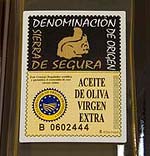

Spain’s olive oils have quality seals provided by the different regional Denominaciones. This ensures that each particular region’s oils retain both their unique taste and high quality.
Similarly to wine, olive oils have quality standards and seals provided by the different Denominaciones de Origen. These are public entities controlled by the Government and they are responsible for the strict and high standards of olive oil production.
Baena - The growing region of this denominacion is in the south-east of the province of Cordoba, covering the Ayuntamientos (municipal areas) of Baena, Luque, Doña Mencía, Nueva Carteya and Zuheros, which are situated in olive growing regions called Nevadillo-Campiña and Campiña y Penibética. It protects extra virgin oils produced from the varieties Picudo or Carrasqueño of Cordoba, Lechin, Chorrúo or Jardúo, Hojiblanca and Picual. The olives are picked by hand, or beaten from the trees with poles or the trees are shaken using machines. Thirty per cent of this of the region's production has this designation. Its oils are fruity, with floral aromas, a little peppery or bitter and have a balance of exceptional flavours.
 Sierra de Segura - This region is located in the north-east of the province of Jaen. The following Ayuntamientos are all included in the production area: Beas de Segura, Benatae, Chiclana de Segura, Génave, Hornos de Segura, Orcera, La Puerta de Segura, Puente Génave, Segura de la Sierra, Santiago-Pontones, Siles, Torres de Albánchez and Villarrodrigo. This Andalucian designation protects virgin oil obtained from the varieties Picual, Verdala, Royal and Manzanillo of Jaen. The olives are picked by hand, and the oils have distinctive aromas and are sometimes slightly peppery.
Sierra de Segura - This region is located in the north-east of the province of Jaen. The following Ayuntamientos are all included in the production area: Beas de Segura, Benatae, Chiclana de Segura, Génave, Hornos de Segura, Orcera, La Puerta de Segura, Puente Génave, Segura de la Sierra, Santiago-Pontones, Siles, Torres de Albánchez and Villarrodrigo. This Andalucian designation protects virgin oil obtained from the varieties Picual, Verdala, Royal and Manzanillo of Jaen. The olives are picked by hand, and the oils have distinctive aromas and are sometimes slightly peppery.
Priego de Córdoba - This denominacion protects extra virgin oil obtained from the varieties Picual, Picudo and Hojiblanca of a natural region located in the south-east of the province of Cordoba, bordering on the provinces of Jaen and Granada. It includes the Ayuntamientos of Almedinilla, Carcabuey, Fuente Tójar and Priego de Córdoba.
Sierra Mágina - Situated within the beautiful Parc Nacional of Sierra Magina , in the central part of southern Jaen. It includes the Ayuntamientos of Albánchez de Ubeda, Bedmar-Garcíez, Solera, Jimena, Jódar, Larva, Mancha Real, Pegalajar and Torres. This denominacion protects the varieties Picual and Manzanillo of Jaen. Its oils are very stable, very fruity and slightly bitter. Their colour varies from intense green to a golden yellow depending on the harvest time and their geographic location within the region.
Sierra de Cazorla - Together with Bajo Aragon, this is the newest Denominacion de Origen. The production area is located in the south-east of the province of Jaen in Andalucia. It covers extra virgin olive oils made from the Picual variety which is characteristic of this region. These are a yellowish green, with an intense fruitiness and fresh fruit flavour (apple, almond, fig), with a slight bitterness and piquancy.
LesGarrigues - It protects oils obtained from the varieties Arbequina, Royal and Morrut. The producing area is a strip of the province of Tarragona, perpendicular to the Mediterranean Sea which, starting from Les Garrigues of Lerida, crosses part of the regions of El Priorato, El Bajo Campo, El Alto Campo, El Tarragonés and La Ribera del Ebro from north-west to south-east. The olives are picked by hand, and as in Les Garrigues, its oils are fruity or sweet depending on the harvest time.
Montes de Toledo - This producing area is located in the center of the Iberian Peninsula, in the region of Castile-La Mancha. More specifically, its 103 towns spread from the southwestern areas in the province of Toledo to the northwestern areas from Ciudad Real.
Bajo Aragón - The provinces of Zaragoza and Teruel in the region of Aragon are the growing area for this Denomination which protects extra virgin olive oil extracted from the Empeltre (minimum 80%), Arbequina and Royal varieties. Its colour varies between golden yellow and old gold. The flavour is fruity at the start of the harvesting period with a slight almond flavour, no bitterness, and a touch of sweetness and piquancy.
(The above information is reproduced by kind courtesy of La Tienda.com)
Click on the links below for more info on olive oil.